Blogging increases your chances of ranking higher in search by 434%.
Starting a blog is a winning way to get found by your target audience and connect with them directly, helping you to deliver valuable information, tips, and advice straight to your readers’ eyeballs.
If you’re looking to get into blogging, there are some key considerations you need to make to help you choose the right blogging platform for you – including the level of customization you’re looking for, potential monetization strategies, email marketing features, and more.
Here’s our expert pick of the top 10 best blogging platforms in 2024 – plus pros, cons, and stand out features for every one.
Follow along or skip ahead:
- Best blogging platforms quicklook
- 10 best blogging platforms in 2024
- How to choose the best blogging platform for you
- 3 tips for starting blogging
- Choose from the best blogging platforms on the market
Best blogging platforms quick look
Best for beginners |
|
|
|
Best for customization |
|
|
|
Best for design |
|
|
|
Best for hobbyists |
|
|
|
Best for data-driven decisions |
|
|
|
Best for content marketing |
|
|
|
Best for a built-in audience |
|
|
|
Best for established businesses and blogs |
|
|
|
Best for budget bloggers |
|
|
|
Best for memberships |
|
|
|
10 best blogging platforms in 2024
Here’s our pick of the best blogging platforms in 2024 – and why we chose them.

One of the best known blogging platforms around, Wix is a powerhouse for creators and business-owners alike. Its super easy drag-and drop website builder has everything you need to get started, including AI tools to make designing your site and writing your content simple.
Create your first site for free with the Wix Free plan and choose from a library of pre-built templates to create a fully customized blog and website – with your ideal layout, brand colors, images, and more. If you want to connect a custom domain and access additional features, you’ll need to sign up for a paid plan, starting from around $4.50 per month.
Wix contains the basic tools you need for building a blog, as well as a straightforward dashboard for writing, customizing and publishing blog posts. It also contains basic SEO features and prompts to help you optimize your content.
This blogging platform is ideal for finding your feet in the world of blogs – but it’s not great for growing your business long-term. The in-built SEO features will only take you so far and you’ll struggle to compete for top ranking spots against bloggers using custom built sites, so it’s not recommended for big-name blogging businesses. That’s why Wix is best for beginners only.
Pros
- Easy to get started
- Affordable pricing
- Basic SEO tools
- Google analytics integration
- Library of pre-built templates
Cons
- Few features on free plan
- Limited advanced SEO
- Less flexibility than custom site
Pricing
- Free plan available
- Paid plans start from $4.50/month
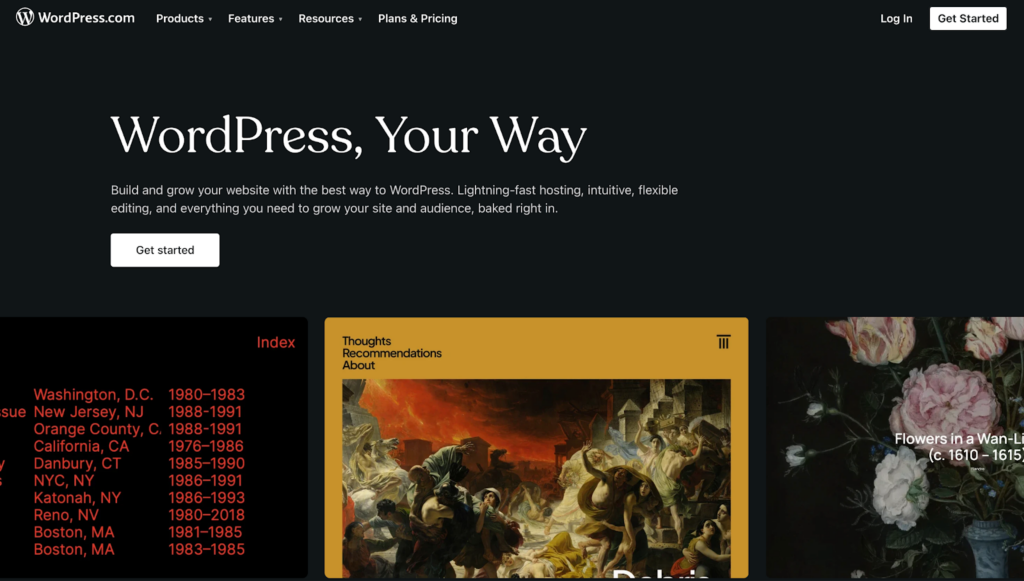
WordPress lets creators build any kind of website – depending on your goals and your needs. It’s hugely flexible and adaptable for any blog or business. WordPress also makes it easy to expand your blog as you go – such as adding digital products, a membership or community space, and more. And if you’re on a tight budget, you’ll be happy to hear that you can get started on WordPress for free!
If you’re looking for an ultra-customized blog and website, you’ll probably want to opt for a WordPress site over more restrictive blogging platforms like Wix or SquareSpace. The downside of WordPress is that it can be overwhelming for complete beginners or non-technical bloggers. It’s helpful to have experience using code to allow you to customize your site and create the blog you’re looking for or get help from outside sources.
Pros
- Fully customizable
- Easy to add and expand as you go
- Plug-ins add extra functionality
- Mobile-friendly themes
- Free to use
Cons
- Less suitable for complete beginners
- Requires some technical know-how
- Weak security
Pricing
- Free plan available
- Paid plans start from $4/month

Loved by small business owners, SquareSpace is a great platform for blogging beginners. It’s ideal for building a seamless, stunning website with minimal time, effort and technical knowledge needed. Choose from a range of templates to suit your style and needs and get a free custom domain too, as well as decent security and privacy measures. SquareSpace websites are mobile-optimized so you can meet your audience wherever they are and on-the-go.
Now for the downsides… SquareSpace has limited flexibility and functionality for bloggers, especially if you’re looking to build a business from your blog. It’s perfect to help you get started, but if you want to expand the reach of your blog in the future, you’ll need to opt for a different blogging platform to take it to the next level.
Pros
- Wide range of themes
- Drag-and-drop builder
- Made for beginners
- Good security and privacy
- Comprehensive customer support
Cons
- Limited SEO functionality
- Doesn’t support complex designs
- Fewer plug-ins than other alternatives
Pricing
- No free plan
- Paid plans start from $16/month
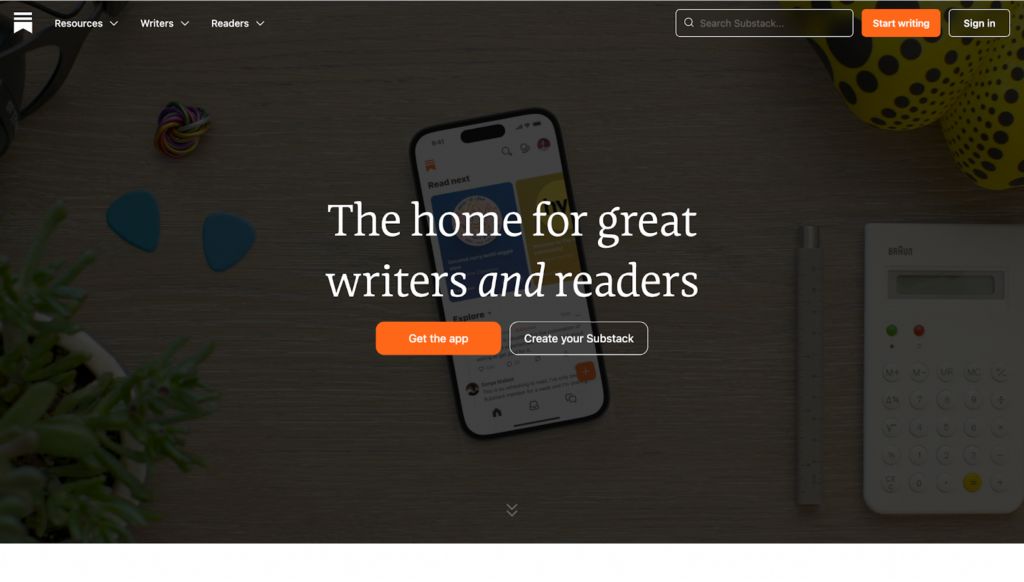
If you’re just looking to start your blog as a hobby or a straightforward side hustle, SquareSpace could be the right blogging platform for you. SquareSpace is a little different to the other options in this list – the platform combines email newsletters with blogging features, helping creators grow an audience of paying subscribers for their work.
Let’s say you enjoy creative writing as a hobby and you want a way to share your work with your audience – be it friends, family or complete strangers. Substack helps you write, publish, and distribute your work using email newsletters. And you can also expand your content to include podcasts, videos, and more.
With Substack, it’s easy to monetize your blog content by setting up subscriptions. Readers who like your content can subscribe and pay to access your premium content or additional resources. This makes it easy to start earning from your work right away.
While Substack has a lot of great features for beginners, it’s not the best blogging platform if you’re looking to build a thriving blogging business. Substack has limited functionality – that’s both the good thing and the bad thing about it. It’s easy to use, but it’s also very basic. You have minimal control over the look and feel of your content and when it comes to SEO, your blog content is linked to Substack rather than your own site.
Pros
- Quick to start
- Easy to distribute content
- Built-in monetization tools
- Keep ownership of your content
- Add podcasts and videos to blogs
Cons
- Platform dependence
- Limited customization for blogs
- Poor SEO features
Pricing
- Free to use
- 10% fee for each transaction through Substack
Related: How to Use Substack Newsletters to Monetize your Audience

Created by the clever people over at HubSpot, CMS Hub is a cloud-based content management platform that’s built with marketing in mind. When it comes to the best blogging platforms, Hubspot’s CMS Hub has a lot to offer in terms of SEO features and data-tracking.
The CMS Hub is all about optimizing your blog for more marketing success – and it includes helpful tools like a fully integrated CRM and recommendations to improve your SEO. With their adaptive testing tool, you can also test up to 5 versions of one page to see which is performing best, allowing you to optimize as you go.
This blogging platform includes a drag-and-drop editor so you don’t need to worry about having coding experience or a developer on hand to help you. And all templates are responsive so your audience can see your content across any device (another plus for your SEO).
Pros
- Responsive templates
- Comprehensive analytics dashboard
- Drag-and-drop builder
- Adaptive testing tools
- Security monitoring & threat detection
Cons
- Need 3rd party solution to backup data
- Not suitable for eCommerce
- Less intuitive than other site builders
Pricing
- Free plan available
- Paid plans start from $23/month
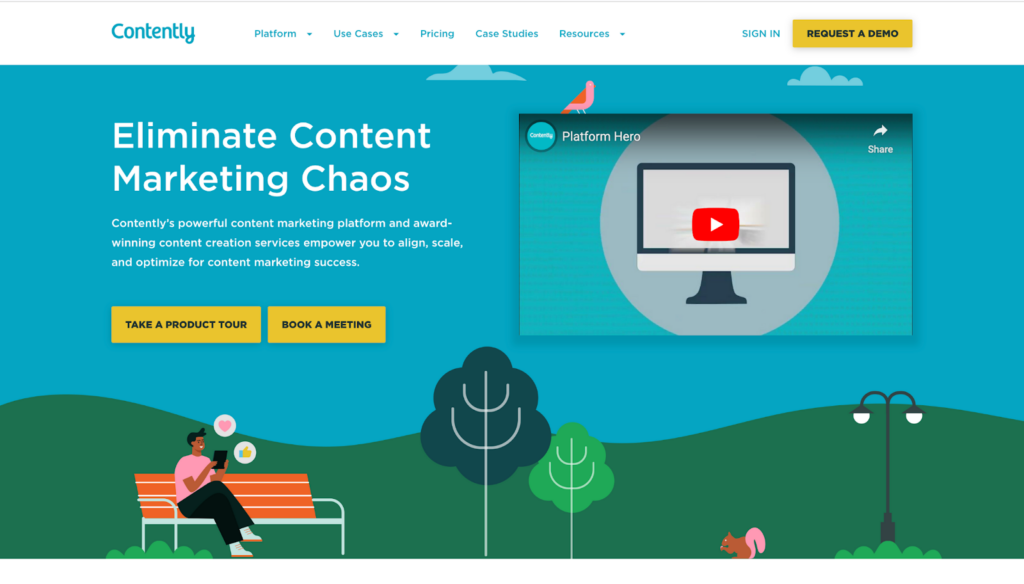
Designed as a content marketing platform, Contently offers businesses the chance to produce and publish content with the help of other creators and content specialists. Originally intended to help brands tell a story, Contently has a range of templates to showcase your content on your own custom-built site. What’s more, their creative marketplace links businesses with freelancers to help write your blog content for you and come up with a comprehensive content strategy for your brand.
When it comes to the best blogging platforms, Contently is geared towards bigger businesses rather than beginners or solo creators. But if you’re looking for done-for-you content from top freelancers, then this could be the choice for you.
Pros
- Tailored to established businesses
- Focus on content marketing
- Create optimized content
- Comprehensive content creation services
- Creative marketplace to find freelancers
Cons
- Less suited to solo creators
- Limited distribution options
- More expensive than other platforms
Pricing
- No free plan
- Bespoke pricing only
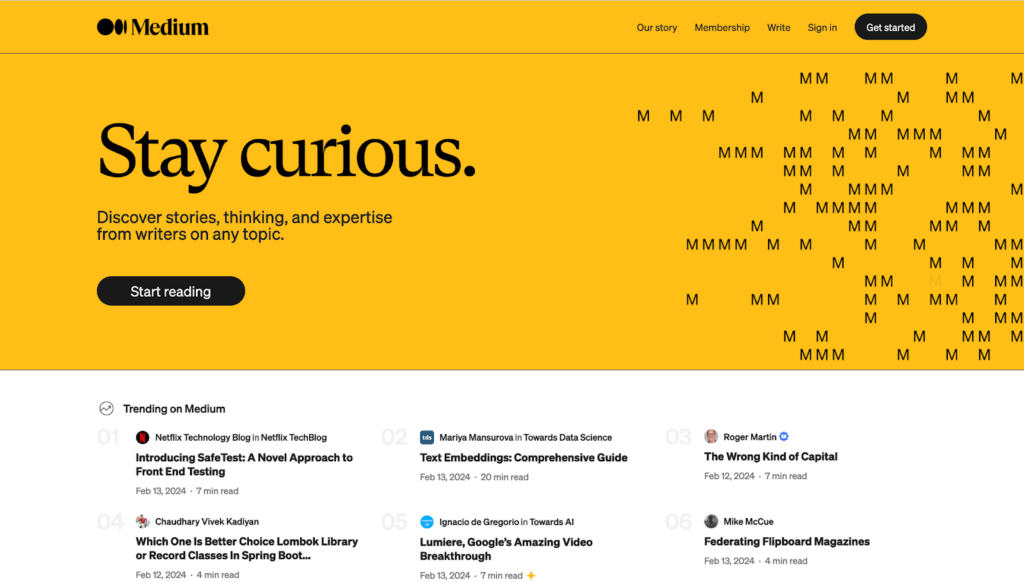
It’s impossible to talk about blogging platforms without mentioning Medium. One of the best-known solutions for bloggers, Medium is all about giving creators a platform to air their views and entertain their audience.
Medium is great for growing your blog quickly and winning fans and followers in record time. Earn money from Medium’s partner program when you reach 100 followers and above – you’ll get a percentage of every readers’ membership fee each month (though the sums are small for most creators).
Another big plus for Medium-based bloggers is their built-in audience. Medium attracts millions of monthly visitors so there’s big potential to get more eyes on your content. Because of the high authority of the site, it’s easier for your content to rank higher in searches too.
But bloggers should be aware that Medium is a nightmare for monetization. If you post on Medium, you can’t post your content anywhere else – and Medium owns everything you publish on their platform. It’s also harder to monetize your Medium blog because of rules and regulations on the site, including restrictions on affiliate marketing that limit your earning potential.
That means you’re effectively handing over your knowledge and ideas to Medium in exchange for their audience. While the system works well for many creators, it’s something to consider when choosing the best blogging platforms for your needs.
Pros
- Built-in audience
- High domain authority
- Grow your readership fast
- Earn through Medium’s partner program
- Easy to write and edit posts
Cons
- Limited monetization options
- No content ownership for creators
- Few customization features
Pricing
- Free plan available
- Paid plans start from $5/month
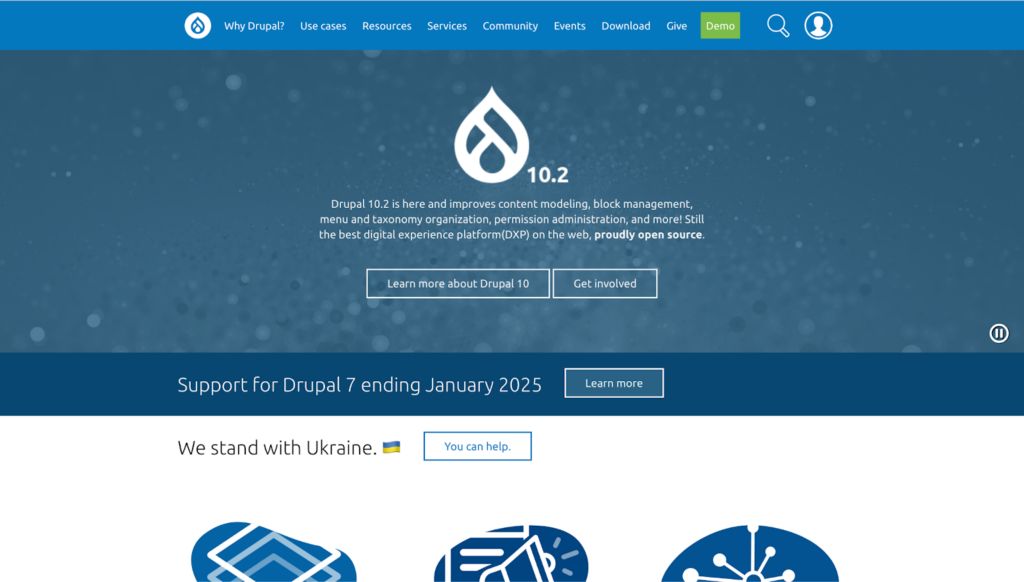
Drupal is a free-to-use open-source software solution that you can utilize to build and grow your own blog. It’s continuously updated and improved and is endlessly customizable. But like all open-source software, it requires some technical knowledge to get started. You’ll need to have some basic coding skills to tailor Drupal to your blogging needs – or enlist the help of a developer instead.
If you have the experience or the budget to customize Drupal for your business then it’s a great choice for blogging. Drupal is used by some of the biggest brands and institutions in the world. And once it’s installed, it’s easy to upload and edit your blogs to your site and there are advanced commenting features built-in too. If you can get over the initial tech hurdle, you’re good to go.
Pros
- Free open-source software
- Completely customizable
- Suitable for blogs of any size
- Intuitive once installed
- Good for security
Cons
- Complex for beginners
- Need technical skills or developer
- Additional web development and maintenance costs
Pricing
- Free to use

Affordable and easy to use, Weebly is a popular choice for bloggers. Targeted at beginners, this blogging platform features a library of pre-designed templates and a simplified drag-and-drop editor for building your site.
Weebly’s template library is less substantial than other competitors and the customization is limited – but if you’re looking for a straightforward route to starting your first blog on a budget, Weebly is a good choice. Their free plan offers a wider selection of features than many others in this list and their paid plans are also not going to break the bank – the most expensive plan bills at $26 per month and includes unlimited storage, advanced insights and priority customer support.
Take advantage of Weebly’s dedicated app store to enhance your site. It’s organized into categories according to the outcomes you’re looking to achieve, including ‘Boost Traffic’ and ‘Spike Sales’. It’s also easy to start an eCommerce site with Weebly when you’re ready to start monetizing your budding blogging business.
Pros
- Affordable pricing
- Good eCommerce features
- Dedicated app store
- Drag-and-drop editor
- SEO beginner guides
Cons
- Limited site customization
- Poor blog customization
- Limited mobile optimization
Pricing
- Free plan available
- Paid plans start from $10/month
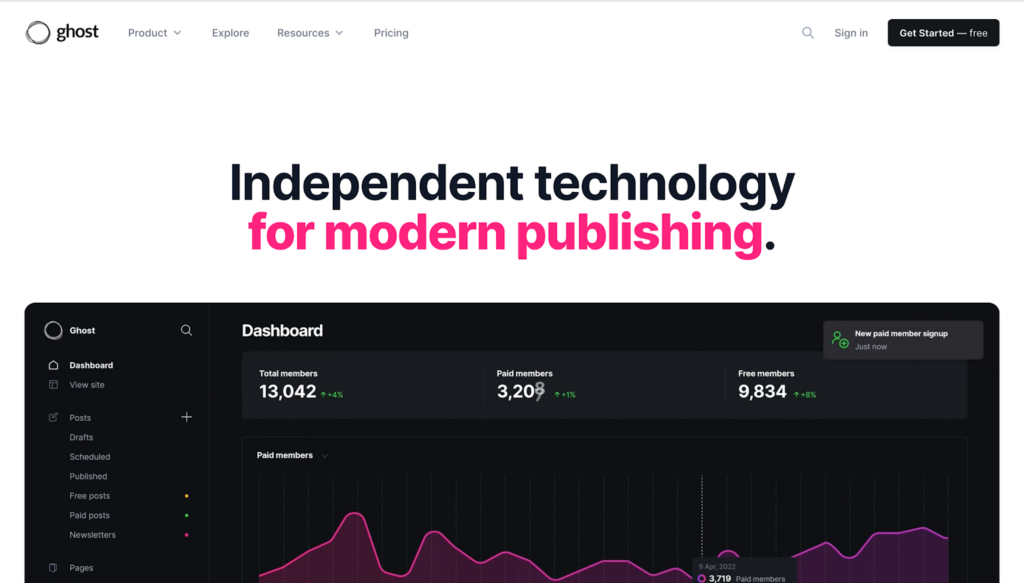
If you’re looking for a dedicated site that’s built for publishing – take a look at Ghost. This blogging platform boasts a range of features dedicated to building a business around your content.
Use Ghost to build a custom website, deliver your blog content, engage your audience with newsletters, and set up paid subscriptions for members. Ghost offers a range of custom themes or the chance to build your own design from the ground up. Enhance your blogs with rich media and dynamic cards, including audio, video, products, and toggles.
When it comes to monetizing your content, Ghost makes it easy to win subscribers with customer offers and promotions, as well as integrations with the tools you’re already using. Link your Ghost site with your existing referral programs, social media channels, payment gateways, and more.
Ghost also takes care of your blog SEO with automatic and custom metadata, automatic updates to XML sitemaps, canonical tags, and structured data. Site performance is also better with Ghost than other blogging platforms. It’s simple and efficient.
Pros
- Dedicated publishing site
- Built-in subscriptions and memberships
- Email marketing features
- Out-of-the-box SEO support
- Customizable themes
Cons
- No plug-ins
- Few blogging integrations
- Limited flexibility
Pricing
- Paid plans start from $9/month
How to choose the best blogging platforms for you
If you’re looking to start a blog for the first time, it’s a good idea to think about the type of blog you want to build and the features you’ll need to be able to do that. Here are some essentials you need to know.
Usability
The usability and simplicity of blogging platforms varies wildly – some are as simple as a few clicks and you’re done. Others call for technical skills and even coding knowledge to go past go.
There are a wide range of user-friendly blogging platforms in this list that are ideal for beginners. Or if you’re looking for something more complex and more customizable, there are options for that too. Be clear on what kind of platform you’re looking for and how long and how much you want to spend to get your site up and running.
SEO features
If you’re starting a blog and hoping to get traffic, you need to be thinking about SEO from the get-go. SEO is essential for helping your blog show up in searches and be seen by your target audience.
While there’s a lot you can do to improve your on-page SEO through your content – such as targeting specific keywords and making sure you offer your readers genuinely valuable info – your technical SEO depends a lot on the platform you’re using.
Technical SEO includes:
- Page speed
- Sitemaps
- Mobile-friendliness
When it comes to SEO, not all blogging platforms are created equal. For example, platforms like Wix, Weebly and SquareSpace are great for getting started as a beginner blogger – but they have serious limits when it comes to SEO.
If you want to build a top-performing blog business, you’d be better off opting for a platform like Hubspot CMS Hub or Drupal, for example.
Pricing
For many bloggers, pricing will be a key consideration when choosing blogging platforms. If you’re concerned about costs then you’ll probably want to opt for the platforms in this list with free and more affordable plans.
But before you sign up, make sure you’re getting the features you need to avoid wasting time and effort on a blog that isn’t fit for purpose.
Customization
If you’re choosing a blogging platform, you’ll also want to think about the level of customization you need for your site to make sure you can put your ideas into practice.
To help you build the blog of your dreams, many of the blogging platforms in this list have built-in libraries of templates and themes for your website. You can then customize the templates to your liking, including:
- Layout
- Color scheme
- Content
Look out for blogging platforms that also have 3rd party add-ons and integrations to enhance your site even further and create a unique blog to show off your expertise.
Storage
While most blogging platforms will give you the option to upgrade your subscription to access more storage space, if you know your blog is going to be data-heavy such as a photo site or video library, make sure your platform and plan has the capacity to handle what you’re trying to build. And be aware that the more storage you need, the more you might have to pay for your blogging platform subscription.
Security
Security is a top priority for any online business in today’s world – it’s essential that you’re able to keep your and your customers’ data safe from malicious activity and attacks. If you know that your blog is going to be handling particularly sensitive information, security should be an even bigger priority.
We’ve highlighted Drupal for their advanced security measures but it’s a good idea to do your own research to make sure that the blogging platforms you’re choosing have the right safeguards in place to protect your customers.
3 tips for starting blogging
If you’re starting a blog for the first time, researching blogging platforms is just the beginning of a long and beautiful journey. Here are 3 more tips to help you start blogging and find success.
Find your niche
If you’re starting blogging as a complete beginner, it’s a good idea to find a specific focus for your blog. This is known as your niche. It is the single topic that will be the cornerstone of all your blog content.
If you already have an existing business or brand, your niche will probably be directly related to your products and services. If you have a blank slate, choose your niche based on 3 criteria:
- Interests
- Expertise
- Profitability
Your blog should ideally tick all 3 boxes. You might find that your niche changes over time or becomes more specific depending on your readership but it’s a good idea to start here.
When you’re picking a niche, it’s also helpful to do keyword research and competitor analysis to see what other blogs are already out there. Try a simple Google search to see how many other blogs are in your niche. A keyword research tool like SEMRush or Ahrefs will help you to get a more detailed picture of how many people are searching for your blog topic and how easy it will be for your content to rank in searches, as well as suggested keywords for you to target in your content.
Related: How to Find Your Niche in 4 Simple Steps
Build a community
In 2024 building a business is all about building a community – and blogging is no different. If you want to attract readers to your blog and gain a loyal following, you need to know who you’re talking to and make sure that your content is written for them. Every post you write should be offering them something of value.
To do that you need to know who your target audience is – including key demographics, their needs, wants, and the problems they’re currently facing. That way you can figure out how to help them. Check out our guide to How to Define Your Target Audience for a more detailed guide.
If you can write for one person – your ideal reader – you can make sure that you’re always producing content that speaks to them. And more people will follow.
By knowing who you’re writing for and why, you can create a community around your brand. And when you’re ready to take the next step, you can even build dedicated community spaces for your readers to forge closer connections with them. Find out how here.
Related: 7 Steps to Building an Online Community (with Examples)
Think about monetization
When you’re starting blogging for the first time, it’s a good idea to think about how you’ll potentially monetize your blog down the line. The monetization strategies you want to use will have a role to play in choosing the best blogging platform for your needs and how you go about creating your content.
Here are a few popular monetization strategies for bloggers:
- Ads: Sell ad space on your blog to make money from visitors to your site. It’s easy to run ads on your website once you have enough traffic – check out Google AdSense as a straightforward way to start earning income from ads.
- Affiliate links: Many bloggers and businesses also earn money from affiliate marketing on their blog – that means promoting other brands’ products or services. When a reader clicks on the link and makes a purchase, you’ll get a percentage of the sale. And it can quickly add up
- Digital products: Digital products are a great way to monetize your expertise and build your brand. If you’re planning to use your blog to promote digital products such as downloadable guides, online courses, and ebooks, you’ll need to find a blogging platform that supports it.
- Membership or subscription: If you have a loyal following for your blog, you can monetize your content by creating a membership or subscription for your readers. Charge your visitors a monthly fee to read your content and join your community – you can incentivize them to sign up with exclusive events, downloads, and resources.
Think about what monetization strategies you’ll use for your blog when choosing your blogging platform to make sure that when the time comes, you’ve got everything you need for a seamless set up. Find out more about content monetization strategies here.
Related: How to create digital products
Choose from the best blogging platforms on the market
Take your pick from our list of the best blogging platforms and get started building your blog right away.
Many creators use blogging as a way to drive traffic to their website – and as an additional income stream too. To find out more about how to build a business through blogging, check out this guide. And when you’re ready to start growing your business and monetizing with digital products, try Thinkific for free.






